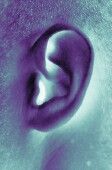Chronic Ear Disease Usually Affects Both Ears
Chronic otitis media in one ear usually signals disease in the contralateral ear, according to the results of a study published in the March issue of the Archives of Otolaryngology -- Head & Neck Surgery.

THURSDAY, March 20 (HealthDay News) -- Chronic otitis media in one ear usually signals disease in the contralateral ear, according to the results of a study published in the March issue of the Archives of Otolaryngology -- Head & Neck Surgery.
Sady Selaimen da Costa, M.D., Ph.D., of the Universidade Federal do Rio Grande do Sul in Porto Alegre, Brazil, and colleagues conducted a study of 500 patients diagnosed with chronic otitis media with or without cholesteatoma.
Structural abnormalities of the contralateral ear were found in 75.2 percent of patients, the researchers report. Among the 60.4 percent of the subjects who presented without cholesteatoma, 69.9 percent had abnormalities of the contralateral ear, while abnormalities were found in 83.3 percent of those with cholesteatoma. Retraction of the tympanic membrane was the most commonly found abnormality, the report indicates.
"Precise and critical analysis of both ears plays a key role in the prognostic assessment of each patient, because the ear established as having chronic otitis media may predict the likely evolution of the contralateral ear. An aggressive cholesteatoma on one side with massive bony destruction and unfavorable evolution should lead us to more vigilant follow-up care of the contralateral ear," the authors write. "In other words, the ears should be analyzed as an intrinsically related pair and not as an isolated unit."
AbstractFull Text (subscription or payment may be required)
Copyright © 2008 ScoutNews, LLC. All rights reserved.
Major congenital malformations not linked to first trimester tetracycline use
November 22nd 2024A large population-based study found that first-trimester tetracycline exposure does not elevate the risk of major congenital malformations, though specific risks for nervous system and eye anomalies warrant further research.